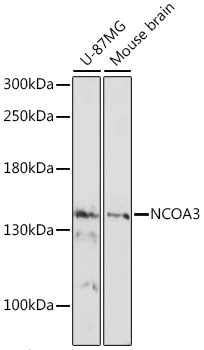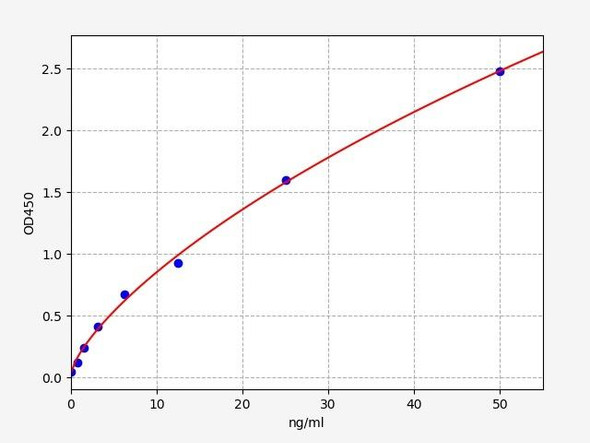Epigenetics & Nuclear Signaling Antibodies 3
Anti-NCOA3 Antibody (CAB17330)
- SKU:
- CAB17330
- Product Type:
- Antibody
- Reactivity:
- Human
- Reactivity:
- Mouse
- Host Species:
- Rabbit
- Isotype:
- IgG
- Antibody Type:
- Polyclonal Antibody
- Research Area:
- Epigenetics and Nuclear Signaling
Description
| Antibody Name: | Anti-NCOA3 Antibody |
| Antibody SKU: | CAB17330 |
| Antibody Size: | 20uL, 50uL, 100uL |
| Application: | WB |
| Reactivity: | Human, Mouse |
| Host Species: | Rabbit |
| Immunogen: | A synthetic Peptide of human NCOA3 |
| Application: | WB |
| Recommended Dilution: | WB 1:500 - 1:2000 |
| Reactivity: | Human, Mouse |
| Positive Samples: | U-87MG, Mouse brain |
| Immunogen: | A synthetic Peptide of human NCOA3 |
| Purification Method: | Affinity purification |
| Storage Buffer: | Store at -20'C. Avoid freeze / thaw cycles. Buffer: PBS with 0.02% sodium azide, pH7.3. |
| Isotype: | IgG |
| Sequence: | Email for sequence |
| Gene ID: | 8202 |
| Uniprot: | Q9Y6Q9 |
| Cellular Location: | |
| Calculated MW: | 147kDa/153kDa/154kDa/155kDa |
| Observed MW: | 155kDa |
| Synonyms: | NCOA3, ACTR, AIB-1, AIB1, CAGH16, CTG26, KAT13B, RAC3, SRC-3, SRC3, TNRC14, TNRC16, TRAM-1, bHLHe42, pCIP |
| Background: | The protein encoded by this gene is a nuclear receptor coactivator that interacts with nuclear hormone receptors to enhance their transcriptional activator functions. The encoded protein has histone acetyltransferase activity and recruits p300/CBP-associated factor and CREB binding protein as part of a multisubunit coactivation complex. This protein is initially found in the cytoplasm but is translocated into the nucleus upon phosphorylation. Several transcript variants encoding different isoforms have been found for this gene. In addition, a polymorphic repeat region is found in the C-terminus of the encoded protein. |
| UniProt Protein Function: | SRC-3: a histone acetyltransferase and nuclear receptor coactivator. Plays a central role in creating a multisubunit coactivator complex, which probably acts via remodeling of chromatin. Involved in the coactivation of different nuclear receptors, such as for steroids (GR and ER), retinoids (RARs and RXRs), thyroid hormone (TRs), vitamin D3 (VDR) and prostanoids (PPARs). Involved in the coactivation of the NF-kappa-B pathway via its interaction with the NFKB1 subunit. Activity is enhanced by various hormones and TNF. Acetylation by CREBBP may suppress coactivation of target genes by disrupting its association with nuclear receptors. Frequently amplified or overexpressed in breast and ovarian cancers. Five alternatively spliced isoforms have been described. |
| UniProt Protein Details: | Protein type:Nuclear receptor co-regulator; Acetyltransferase; Transcription, coactivator/corepressor; EC 2.3.1.48; Motility/polarity/chemotaxis Chromosomal Location of Human Ortholog: 20q12 Cellular Component: cytoplasm; nuclear chromatin; nucleoplasm; nucleus Molecular Function:androgen receptor binding; chromatin binding; histone acetyltransferase activity; ligand-dependent nuclear receptor binding; ligand-dependent nuclear receptor transcription coactivator activity; nuclear hormone receptor binding; protein binding; protein dimerization activity; protein N-terminus binding; thyroid hormone receptor binding; transcription coactivator activity Biological Process: androgen receptor signaling pathway; histone acetylation; multicellular organism growth; positive regulation of keratinocyte differentiation; positive regulation of transcription from RNA polymerase II promoter; positive regulation of transcription, DNA-dependent; transcription from RNA polymerase II promoter; vagina development |
| NCBI Summary: | The protein encoded by this gene is a nuclear receptor coactivator that interacts with nuclear hormone receptors to enhance their transcriptional activator functions. The encoded protein has histone acetyltransferase activity and recruits p300/CBP-associated factor and CREB binding protein as part of a multisubunit coactivation complex. This protein is initially found in the cytoplasm but is translocated into the nucleus upon phosphorylation. Several transcript variants encoding different isoforms have been found for this gene. In addition, a polymorphic repeat region is found in the C-terminus of the encoded protein. [provided by RefSeq, Mar 2010] |
| UniProt Code: | Q9Y6Q9 |
| NCBI GenInfo Identifier: | 23396777 |
| NCBI Gene ID: | 8202 |
| NCBI Accession: | Q9Y6Q9.1 |
| UniProt Secondary Accession: | Q9Y6Q9,Q0VF45, Q5JYD9, Q5JYE0, Q9BR49, Q9UPC9, Q9UPG4 Q9UPG7, A4LAZ5, |
| UniProt Related Accession: | Q9Y6Q9 |
| Molecular Weight: | 154,892 Da |
| NCBI Full Name: | Nuclear receptor coactivator 3 |
| NCBI Synonym Full Names: | nuclear receptor coactivator 3 |
| NCBI Official Symbol: | NCOA3 |
| NCBI Official Synonym Symbols: | ACTR; AIB1; RAC3; SRC3; pCIP; AIB-1; CTG26; SRC-3; CAGH16; KAT13B; TNRC14; TNRC16; TRAM-1; bHLHe42 |
| NCBI Protein Information: | nuclear receptor coactivator 3 |
| UniProt Protein Name: | Nuclear receptor coactivator 3 |
| UniProt Synonym Protein Names: | ACTR; Amplified in breast cancer 1 protein; AIB-1; CBP-interacting protein; pCIP; Class E basic helix-loop-helix protein 42; bHLHe42; Receptor-associated coactivator 3; RAC-3; Steroid receptor coactivator protein 3; SRC-3; Thyroid hormone receptor activator molecule 1; TRAM-1 |
| UniProt Gene Name: | NCOA3 |
| UniProt Entry Name: | NCOA3_HUMAN |







